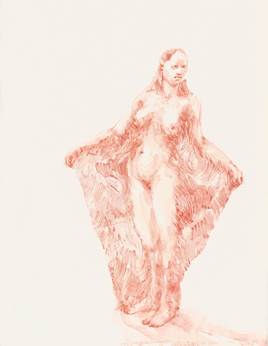
Bea Emsbach
Im Inneren Wald
Zeichnung und Skulptur
Eröffnung Sonntag, 3. November 2019, 12 bis 15 Uhr
Ausstellungsdauer bis 7. Dezember 2019
(Scroll down for English)
Zeichnen als Ringen um Bilder aus dem Unterbewusstsein und Mythen, aber auch Beschäftigung mit Anthropologie und Psychologie, so beschreibt Bea Emsbach ihre Arbeit. Und darauf weisen auch die Titel ihrer Serien hin: „Beutezüge im Bodensatz der Wissenschaften“, „Die Anthropologin unterwegs“, „Haushaut“, „Hautsache“, Ereignisse im Schatten“. Markenzeichen der Künstlerin ist die Farbe Rot, ursprünglich rote Tinte, mit der sie zu Beginn ihrer künstlerischen Laufbahn lineare Zeichnungen meist in A4 Format anfertigte. Sie wirken wie Studien zu fernen Völkern, zuweilen alptraumartig in ihren seltsamen Verkabelungen und Enthäutungen, unheimlich und schön zugleich. Es folgten parallel dazu nach Jahren Aquarelle. Die Themen änderten sich dabei nicht, aber die Kompositionen wurden malerischer und die Raumdarstellungen bildhafter und mit größerer atmosphärischer Dichte. Damit verschob sich der Studiencharakter der Werke mehr zum Erzählerischen hin. Emsbach benutzte in dieser Phase immer noch den Kolbenfüller, mit dem sie eine eigene Aquarelltechnik entwickelte. Blätter aus beiden Phasen sind in der Ausstellung zu sehen.
Im Schwerpunkt der Ausstellung sind aber Werke der jüngsten Entwicklung zu sehen. Nicht nur benutzt sie neuerdings ausschließlich den Pinsel, wobei sie ihre Arbeiten auch als „Pinselzeichnungen“ bezeichnet, sie verwendet auch keine Tinte oder handelsübliche Farben mehr, sondern mischt selbst, unter anderem aus Pigmenten verschiedener Zinnobertöne eigene Aquarellfarben an. So orientiert sie sich zum Beispiel am feurigen Rotton eines William Turner (Brand des Parlaments) mit Rezepturen aus dessen Zeit. „Im Inneren Wald“ spielt einerseits auf Forschungsergebnisse eines subjektivistischen Naturstudiums als Imaginationen anthropomorpher Pflanzen und Protagonisten eines Naturvolkes an, deren Riten ein Stückweit rätselhaft bleiben und eine Vielzahl an Assoziationen hervorrufen. Andererseits geht es aber auch um den Rückbezug auf das „Innere Selbst“, ein Begriff aus der Psychologie. Im Hinblick auf die besonderen Farben der Aquarelle könnte man auch noch vom „künstlerischen Selbst“ sprechen, in dem Emsbach Traditionen weiter auslotet, in denen sie steht.
Zu den Papierarbeiten kommen Skulpturen aus gebrannter, synthetisch-keramischer Modelliermasse (Polymerton), die wie dreidimensionale Fassungen der Wesen aus ihren Zeichnungen wirken und an die Kunst- und Wunderkammern der Renaissance erinnern.
_________________________
Bea Emsbach, Im Inneren Wald (In the Inner Forest). Drawing and Sculpture.
Opening Reception Sunday November 3, 2019, 12pm to 3pm
Duration December 7, 2019
Drawing as a struggle for images from the subconscious and myths, but also preoccupation with anthropology and psychology, this is how Bea Emsbach describes her work. And this is also indicated by the titles of her series: “Beutezüge im Bodensatz der Wissenschaft”(„Forays in the dregs of science“), “Die Anthropologin unterwegs” („The anthropologist on the move“), “Haushaut” („House skin“), “Hautsache” („Skin thing“), “Ereignisse im Schatten” (“Events in the shadows”). The artist’s trademark is the color red, originally red ink, with which she made linear drawings, mostly in A4 format, at the beginning of her artistic career. They seem like studies of distant peoples, sometimes nightmarish in their strange wiring and skinning, eerie and beautiful at the same time. Watercolors followed years later. The themes did not change, but the compositions became more painterly and the spatial representations more pictorial and with greater atmospheric density. This shifted the study character of the works more towards the narrative. In this phase Emsbach still used the piston fountain pen, with which she developed her own watercolor technique. Sheets from both phases can be seen in the exhibition.
The focus of the exhibition, however, is on works from the most recent developments. Not only has she recently only used the brush, although she also calls her work “brush drawings”, she also no longer uses ink or commercially available colors, but instead mixes her own watercolors herself, using pigments of various cinnabar tones, among other things. For example, it is based on the fiery red shade of a William Turner (Brand of Parliament) with recipes from his time. On the one hand, “In the Inner Forest” alludes to the research results of a subjectivistic study of nature as imaginations of anthropomorphic plants and protagonists of a native people, whose rites remain somewhat puzzling and evoke a multitude of associations. On the other hand, it is also about referring back to the “inner self”, a term from psychology. With regard to the special colors of the watercolors, one could also speak of the “artistic self”, in which Emsbach further explores the traditions in which it stands.
In addition to the works on paper, there are sculptures made of fired, synthetic ceramic modeling clay (polymer clay), which look like three dimensional versions of the creatures from their drawings and are reminiscent of the cabinets of art and curiosity of the Renaissance.
